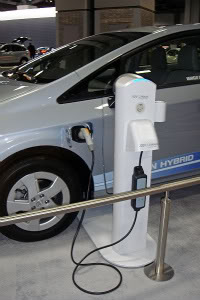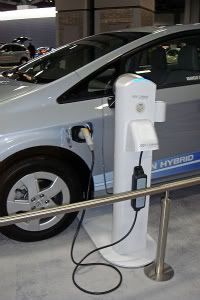Where Is the Electric Vehicle Industry Going? Judging by the 2010 Plug-In Show…


In a word: small. The main impression that anyone would take away was how incredibly and unforeseeably tiny the event was compared with those of past years. I can’t be precise about this because, in truth, I never stopped to measure, for instance, the 2008 event, held in the same place (San Jose’s McEnery Convention Center). But yesterday, we had 38 exhibitors (down from many hundreds) in a floor space that could have accommodated a tennis match, and (I’m guessing) perhaps only a thousand or so attendees.
So what happened? I’m not 100% sure, but I have a guess.
In the EV space, the die is cast. Even now, it’s abundantly clear where the industry is going and who many of its winners and losers will be. Yes, there are tons of important details yet to emerge. But the large OEMs, unless they (once again) default on their promise to put EVs on the road in a supply that matches demand (which won’t happen), have changed the game for small businesses that may have aspired to be a part of this industry.
A few years ago, companies that may have contemplated introducing a new vehicle type, or business model, or component, or drive train, or new battery chemistry – had literally millions of people interested. Might someone somehow supersede the OEMs in an important automotive segment and rewrite the Tucker story? Might one or more small companies win the day if the OEMs pulled a stunt similar to that of the 1990s and withdrew from the industry? Maybe the big guys would buy up a few of them, and founding inventors and investors would be instantly rich. Now many of the answers here are already clear.
Yes, the OEMs have their plans in place. Sure, some of these plans are on the table for anyone to see, e.g., Nissan, while others are carefully kept secrets, e.g., Chrysler/Fiat. But the fact remains that the OEMs have come to play, rendering this whole arena far less exciting for the little guys.
Now, this is hardly a big surprise. Consumers demanded EVs and big auto responded. For once the auto industry appears to have gotten it right. And aggressively pursuing an EV strategy is a can’t-lose proposition. Even if there are mismatches between EV supply and demand, any short-term losses the OEMs absorb will be more than offset by the millions of dollars of free PR they receive.
Say you want a pure-electric car, and you’re not worried about running out of charge and getting stranded. Maybe you’re one of tens of millions of two-car families, and one of your drivers commutes to and from work less than 100 miles per day. Want a really well appointed EV that is backed by a company with the size, strength, and credibility of Nissan and that, after rebates, costs far less than $20,000? The LEAF is for you. It really is a damn nice car; they’ve done an amazing job.
Perhaps you have “range anxiety” – or simply still want your car available for trips out of town? You can pick up a Chevy Volt for about $33,000 after rebates. That too is terrifically sexy and well designed, with bluetooth, a GPS – and all the other bells and whistles of modern automotive engineering.
So again, what does this mean in terms of trade shows like Plug-In?
A great number of folks who should have seen the handwriting on the walls – but didn’t – were notably absent yesterday – never to return. Gone are the hobbyists with conversion shops in their garages, the inventors whose ideas didn’t make the “A” list, and the visionaries with ideas that didn’t suit the interests of the Fortune 100; they’ve all been driven with sticks from the EV game.
Are there still innovative business models to be pursued? Are there still breakthroughs in design, battery chemistry, and fast-charging to be launched? Absolutely. But there are far fewer people chasing these ideas than there were a couple of years ago – and what I saw yesterday was proof.


Dear Craig:
Yes the auto industry, crushed most of the grassroots
and small to medium innovative EV initiatives from companies
and individuals, once the humongous subprime crisis changed
the world since fall 2008.
Carmakers’ only road to survival was ‘green’ government funding
in North America, Europe and Asia alike. Which gave birth
to peculiar phenomena: a) First time in history that the
auto industy develops models without a target customer
(Leaf, Volt, etc.). b) First time in history that the auto
industry ‘say’ that they are going to pursue a business
model of practically no aftermarket income (due to the
well documented minimum maintenance f EVs).
Well there are many niches that all of Mr. Ghosn blabber
will not cover. Needed CO2 reduction in transportation
will not be met by carmakers’ offerings alone, even
making hybrids or efficient diesels their core business
(a very distant option, if you ask me).
So yes there are innovative business model to be pursued,
but all are as profitable as are difficult to pursue…
but this is 2010, not the sixties, so lets plow ahead.
Hi Craig,
I was disappointed, too, at how limited the Plug-In 2010 has been and I agree with your assessment.
However, I did enjoy some of the sessions, in particular the one about innovative business models in the electric transportation space. The paths that some entrepreneurs take are inspiring.
Here is a write up about three different emerging business models http://www.examiner.com/x-12791-Bay-Area-Green-Careers-Examiner~y2010m7d31-Innovative-business-models-in-the-electric-vehicles-industry
Best regards,
Michal